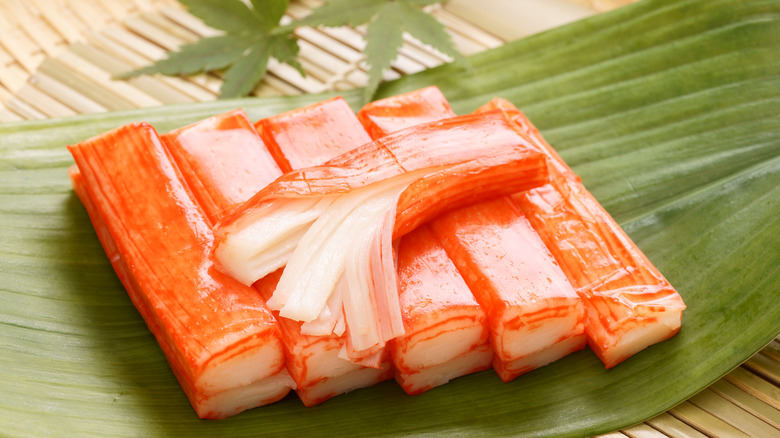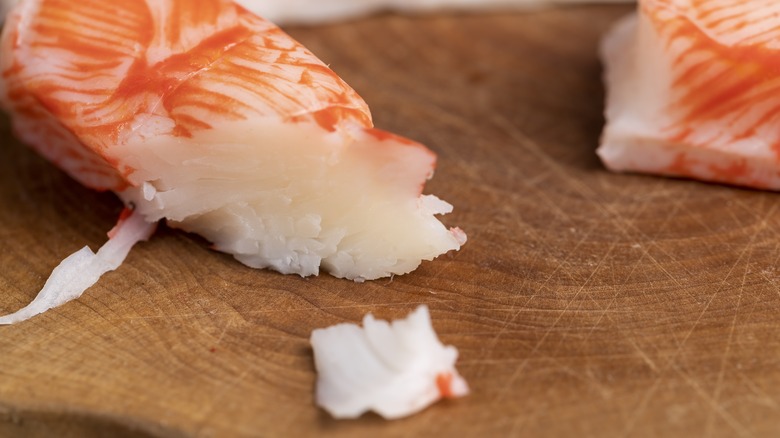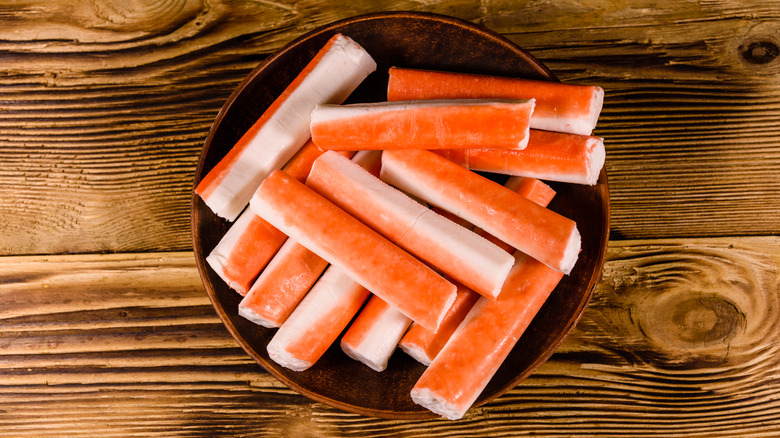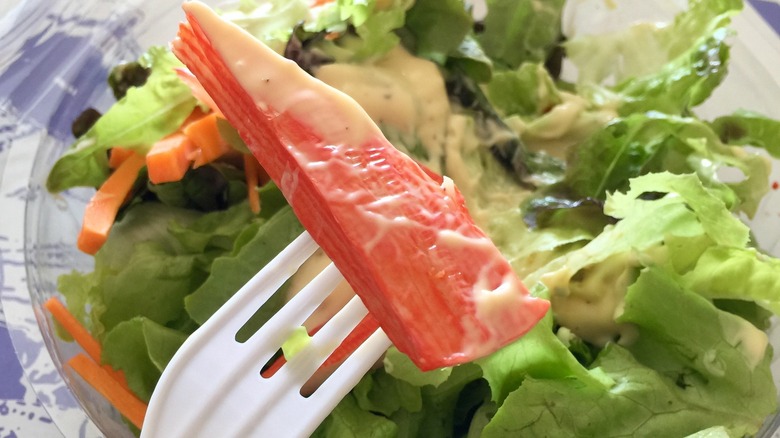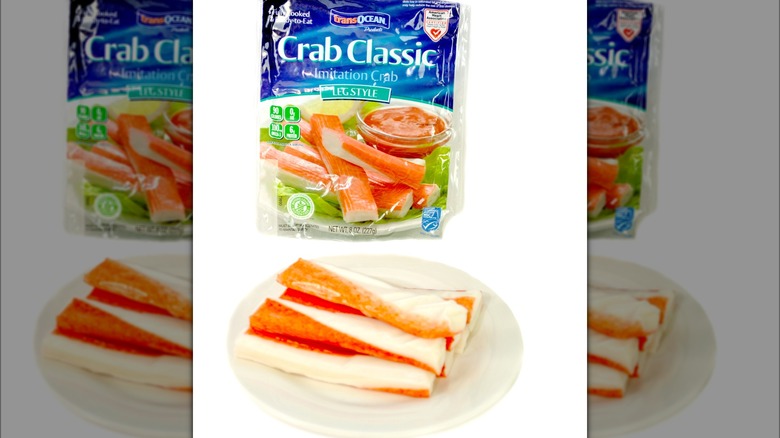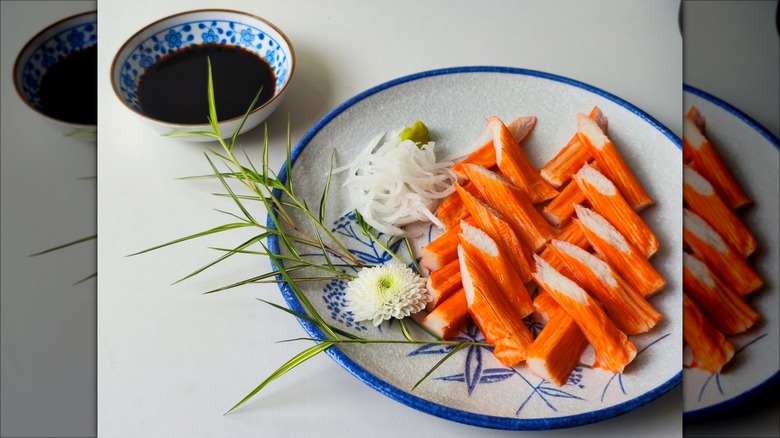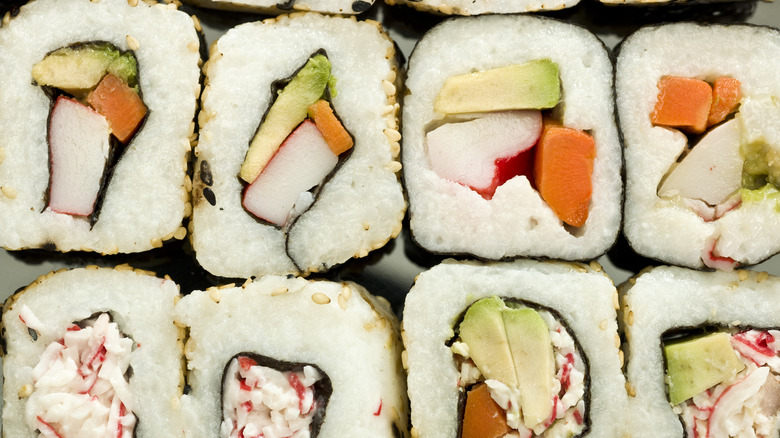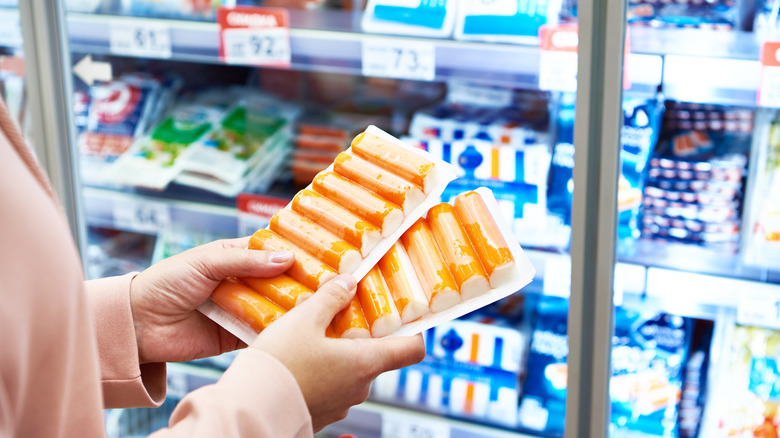What Is Imitation Crab Made Of?
There are several types of crab, including king, Dungeness, and blue. But what about imitation crab? Is it really crab? And, if not, what is it made of? Imitation crab's history dates back to the 1970s, which makes it a relatively recent invention. Chefs and other food manufacturers in Japan were looking for something that they could serve in place of crab, which, even then, was pretty expensive.
Since its invention, imitation crab has become rather popular — many brands are available on the market. Whether you're a fan of this fishy-creation or have never tried it, you may be wondering exactly what it is. So, we decided to take a deep-dive at the ingredients used to make imitation crab and how it is made. We'll also explore nutritional information, see how it stacks up when compared to real crab, and look at some of the different ways you can cook with or serve imitation crab. You might be surprised by what you learn, or even discover that you've had imitation crab before, and you just didn't realize you were eating it.
What are the ingredients in imitation crab?
While real crab has just one ingredient (crab), imitation crab combines a few different ingredients together to try and mimic the taste of the real thing. The main ingredient is surimi, a special type of fish paste. While the paste can be made from a few different types of fish, Alaskan Pollock is the most common type used to make it. Pollock is known for its milder flavor, which helps manufacturers adjust its taste to make it more like real crab meat. Some imitation crab formulations may substitute blue whiting, Pacific whiting, or flounder for the pollock. The exact ratio of surimi paste can vary between different brands of imitation crab, but it typically makes up between ⅓ and ½ of the entire formulation.
Additional ingredients are needed to give the surimi paste the right flavor and texture when making imitation crab. Egg whites or other proteins are added to help achieve the right texture and color while also helping give imitation crab a similar sheen to the real deal. Wheat, potato, corn, or other starches are also added to the mix to help the "crab" maintain a firm shape and allow it to be frozen, while vegetable oils are often added to enhance the texture and extend the product's shelf life. A few other common ingredients include water, salt, sugar, and sorbitol.
How is imitation crab made?
Before making imitation crab meat, the surimi must be prepared. To make this fish paste, pollock — or sometimes other types of fish — is pulverized or very finely minced before being combined with the other ingredients and heated up. This warmed-up mixture is then pressed into molds to shape it to look similar to real crab meat — picture the long strips of crab that you pull out of the leg after cracking it.
Part of the production process also involves preparing the "crab" to be sold in a store. The meat is pasteurized to ensure any potentially dangerous bacteria or viruses are killed. Without this step, one's chances of getting food poisoning from eating the imitation crab would be much higher. Finally, the packages are vacuum-sealed before being shipped to a grocery store for you to purchase.
What does imitation crab taste like?
Imitation crab was created to mimic the taste of real crab. And, for the most part, the "meat" does a good job of achieving this. Its taste and texture are very similar to those of real crab. Both seafood options have a hint of sweetness combined with a touch of saltiness. Unless you're a true seafood connoisseur, you may be unable to tell whether you're eating real crab or imitation crab by taste alone.
While taste might not help you identify whether you're eating real crab or imitation crab meat, other things can help you solve the mystery if you're dining at a restaurant or picking up something to prepare for dinner from the grocery store. The name on a package or menu should also clue you in. If the meat isn't directly called out as being "imitation," you could also see it labeled as krab, crab sticks, or surimi seafood. If you're traveling to Japan, imitation crab is often called kamaboko.
Imitation crab vs. real crab
We just touched on how imitation crab stacks up to real crab when it comes to taste, but you may be curious about some of the other differences between the real thing and its imposter. One key difference is the price. Just as pure maple syrup is more expensive than other varieties, real crab is more expensive than fake crab. While the cost can vary by region, the type of crab you're purchasing, and whether you're ordering from the grocery store, a fish market, or getting it straight from the docks, it is not affordable for many and can cost over $30 per pound. Imitation crab, on the other hand, is much less expensive. At the time of this writing, Walmart was selling a 20-ounce bag of imitation crab legs for $5.32, which is around $4.30 per pound.
Similarly, imitation crab may be more readily available. Depending on where you live, you may not have access to fresh crab legs, while many grocery stores keep imitation crab meat in stock. Another thing to consider is ease of use. Imitation crab meat is ready to use right out of the bag. However, real crab legs are far more laborious to prepare. You'll need to cook them first, crack the shells, and remove the meat before you'll be able to eat it or use it in a recipe.
How nutritious is imitation crab?
While imitation crab may be more convenient, less expensive, and easier to find than real crab, it is not as nutritious. Each 85-gram serving has about 80 calories, 6.5 grams of protein, 12.8 grams of carbohydrates, 0.4 grams of fat, and 450 milligrams of sodium. There are also several vitamins and minerals in the "meat."
A serving of imitation crab provides about 35% of the recommended daily value of selenium, 21% of the recommended daily value of vitamin B12, 19% of the recommended daily value of phosphorus, and 9% of the recommended daily value of magnesium. There is also some copper and zinc in imitation crab. However, each serving only offers 3% of the recommended daily value for these two minerals.
At first glance, real crab may seem similar to imitation crab, having about the same calories and slightly more fat per serving. However, that is where the similarities end. Real crab has no carbohydrates and is a better source of protein (16.5 grams per 85-gram serving). It also offers significantly higher amounts of essential vitamins and minerals — each serving contains 408% of the recommended daily value of vitamin B12, 111% of the recommended daily value of copper, and 62% of the recommended daily value of selenium.
Imitation crab may not be safe for those with a wheat allergy or gluten sensitivity, as many formulations include wheat to thicken the paste. There are a few safe alternatives, but you'll need to do your research.
How do you cook with imitation crab?
Imitation crab lends itself well to a wide variety of recipes. Because it is already cooked, it is also simple to prepare and can be added directly to dishes with minimal prep outside of opening a package. Some of the most popular uses for imitation crab involve sushi and crab rangoons. You can also use the "meat" to make crab salad, add it to dips, use it to stuff ravioli, or incorporate it into soup recipes. Imitation crab may be sold in sticks, shredded, or in chunks. The specific format of the type you choose can impact which recipe types it is best for. For example, imitation crab sticks may be better for dipping in cocktail sauce as an appetizer, while shredded imitation crab would be better suited for making "crab" cakes.
Generally, you can substitute imitation crab for recipes that call for real crab legs. You don't need to worry about cooking or cracking crab legs, either, as imitation crab is ready right out of the packet. If you do buy real crab legs, though, the Whole Foods Fishmonger could help you with this.
Where do you find imitation crab in the grocery store?
Imitation crab meat is available in most grocery stores, including big chains like Walmart, Kroger, Albertsons, Aldi, and Whole Foods. Depending on your grocery store and the specific brands of imitation crab meat they carry, you may find it in the freezer or refrigerated section with other frozen seafood. Some of the major imitation crab brands include Trans-Ocean, Louis Kemp Crab Delights, Fremont Fish Market, and Dyna-Sea. Pricing may vary between regions, grocery stores, and package sizes/meat styles, so be sure to research before shopping.
If you don't see any packages labeled imitation crab, remember that this seafood product sometimes goes by different names. It could also be labeled surimi seafood, crab-flavored seafood, or krab. If you're lucky enough to have multiple brands or formulations available, take a few minutes to compare the packages. Look at the specific breakdown of ingredients, whether any real crab was added to the mix, and whether there are any allergens present, if applicable.
If you're focused on minimizing your environmental impact, you may also want to seek out imitation crab that is not made using Alaskan Pollock. There are concerns about overfishing and removing the food source for Steller sea lions, who are now endangered. Opting for imitation crab made with Pacific whiting, cod, or other sustainable options can help avoid contributing to this ongoing problem.
How do you store imitation crab?
While imitation crab is not real crab, it is made with real fish. This means it is perishable and should be left in the freezer or refrigerator to prevent spoiling. If you plan to use the imitation crab meat you purchase soon, you can put it in the refrigerator. However, it is recommended to keep the meat refrigerated for up to 30 days. So, if you don't have an immediate plan to use it, put the package in the freezer and remove it to thaw before you're ready to cook or eat it.
Imitation crab meat can be stored in the freezer for an extended period of time. However, to ensure the freshest taste and texture, it is probably best to eat it within a year or year-and-a-half. Once you open a pack of imitation crab, you should eat it within three to five days to minimize the chances of foodborne illness.
